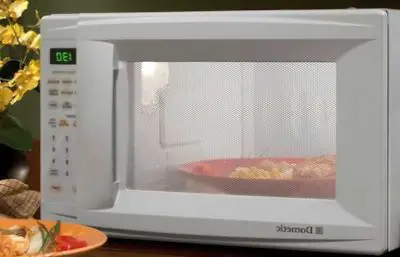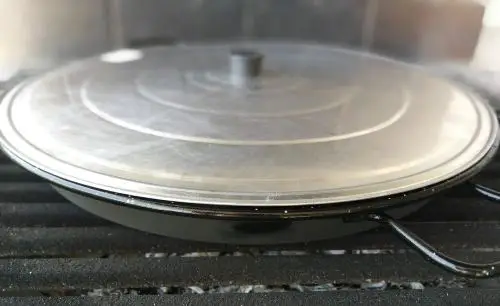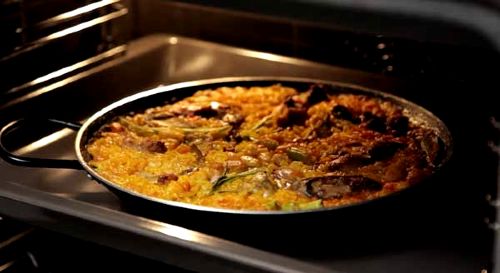Reheating paella rice or any other Spanish rice dishes is something easy if you know the theory and the technique.
So, can you reheat paella? Of course, you can. We always defend making the most of the leftovers, but how to reheat paella without spoiling it?
Except for most spoon dishes, few foods taste the same if they are not eaten freshly made. A series of chemical processes are involved in the cooking process that transforms the characteristics of the food, and when it cools and reheats, it changes again. But that does not mean that we have to suffer from overcooked, dry or tasteless leftovers.

Then, you can reheat paella and enjoy a very appetizing dish almost as freshly made. You will learn the best way to reheat paella safely and successfully.
How to reheat paella
The method to reheat paella varies depending on the way it has been made, I mean, whether the rice once made, keeps no broth, just a creamy little bit o the rice is just “dry”. Them the chances on succeeding will also be different.
Loose rice dishes
By “loose rice” I mean not creamy or soupy rice, so, the liquid is evaporated when ready. This is:
Therefore, most types of paella and Spanish rice dishes are among them.
Moreover, this is valid for a side dish of white rice, a stir-fry; the loose rice loses moisture and stops having this light and fluffy texture as the hours go by. There are several methods to bring them back to life.
Bain-marie
It is a simple and non-invasive technique that allows good control of the rice at all times. All you have to do is put a ladle or a pot of water to heat, put the rice in a pot or a sieve and put it on top, without it ever touching the water. Stir it little by little so that the rice recovers humidity in the meantime it is heated.
Microwave
Reheat paella in a microwave is fast, convenient and, in theory, easy. Microwave is the king of leftovers. But, again, we don’t want dry rice or uneven heating. The ideal is to reheat small portions on a wide plate or platter. You can also put a damp paper towel on it and cover it with the microwave protector, this generates steam and makes the rice moist.
It is also advisable to set a non-very-high heat power and work in short periods of time, checking the point little by little and stirring in the middle of the cooking, so that the heat is distributed homogeneously.
This is my favorite way. I never set high heating, it is preferable setting more time and lower heating.

Oven
I would never think of turning on the oven just to reheat leftovers, but if we have to use it for another dish we can take advantage of it. You can lower the temperature to about 140ºC or simply take advantage of the residual heat from a previous preparation. In any case, it is also advisable to add moisture (water or stock) to the rice.
I have read on more than one occasion a trick that I don’t know if it will work very well: cover the top with beaten egg whites, to avoid crusting. I imagine it will work better with large amounts of paella, but I would say that the proteins in the whites will leave a different texture to the grain.
Skillet
There are great advocates of pan-reheated paella who even claim that paella is nicer that way, the next day. The technique is simple: heat some oil in a good non-stick frying pan, pour the paella with all its ingredients, and cook over low heat for about 10 minutes. Always stirring but let the rice get a little bit soggy.
If it is too dry, add water or, even better, stock, which hopefully will be leftover from the day before. Paella reheated in a frying pan becomes very brown and acquires a slightly different, more pronounced taste. The grain of rice becomes loose, toasted slightly – or very much, depending on how you like it – and becomes tastier with light frying.
This is an ideal technique for stir-fry and fried rice, for obvious reasons. The procedure is the same, and we can adjust on the fly the exact point, more or less fried or toasted. Also in a frying pan, it can be reheated without adding oil, using a water or broth base, as if we were cooking it.
Wet rice (creamy or brothy)
This category includes sweet and sour rice, soups and risottos. A soup in principle has no more mystery, it is taken to the fire in a pot and ready, but the other rice dishes are more complicated. Regarding paella and Spanish rice dished, it could be included creamy ones (when they are creamy) such as:
- Seafood paella
- Prawn paella
- Mixed paella
- Rice with lobster
- …
In the pot with more broth
Reheating rice in a pot is an adequate technique for brothy rice, which is not a soup but has a good amount of liquid. When it cools down it will thicken, so the easiest thing to do is to return it to a pot, not too strong, with more broth, so that it recovers its texture more like a spoon. If we cook it well the first time, a reheated broth can be even richer.
Microwaves
Yes, reheating creamy or brothy rice is also possible using a microwave. However, my recommendation is to set low-medium heat and not so much time, just me the minimum necessary to be tempered. Otherwise, we may overcook the rice, hence ruin it.
Important consideration.
Creamy Spanish rice dishes are not easy to reheat, because you mighty end up with an overcooked rice dough.
The pro trick is to use bomba rice instead of normal paella rice, as it allows more cooking time.
If the rice is initially overcooked, there won’t be anything to do for a proper result. However, it will always depend on how demanding with food you are.
Reheating Seafood Paella
Reheating seafood paella can be satisfactory, depending on if it was a creamy dish or not.
As we saw before, if the rice is done to perfection, it allows reheating by one of the methods seen above. Meaning:
- Microwaves
- Oven
- Frying pan
However, seafood paella is sometimes creamy (depending on the recipe), and this makes reheating more “dangerous“. In this case, using bomba rice will ease the process of reheating without
If the rice was initially overcooked, unfortunately, there won’t be any chance to get a perfect dish once reheated.
Reheating frozen paella
Reheating paella that has been frozen is something also doable if you follow my recommendations:
- Let it defrost slowly, the slowest, the better. So, the best way is to keep it room temperature until ready.
- If you don’t have much time, place the “Tupper” close to a heat source.
- If you don´t have any time, just defrost it at the microwave the slowest possible
Of course, the result won’t be as good as if it was not frozen, but it can be nice. However, it will always depend on the first cooking.
Best way to reheat paella
Through this article, we have seen many techniques to reheat Spanish rice dishes. In my opinion, the best way is bain-marie, because is the less invasive method, but it will take much effort. Besides, we don’t have always access to suitable tools and a kitchen.
Then, the most convenient method is to microwave if we are careful with time, It is preferable to eat the rice just tempered than overcooked.
We might need to keep the paella rice or warm for many reasons. Either because we have to cook several things at the same time or because our guests are late, the truth is that this can happen. And we don’t want the paella we have been cooking with all our love to arrive cold at the table.
Can you keep paella warm?
The fast answer is yes, you can keep paella and Spanish rice dishes warm but not for much time. In this article, I’m going to reveal some tricks that restaurants use to keep food warm. But no worries, with some modification we can use them at home.
So, here we are some tricks to keep the paella hot until it is served at the table
Leave the paella pan with the heat off
A very effective way to keep food warm is to leave them on the cooker with the heat off. Vitro ceramic retains residual heat, so this is a valid way if the lid remains slightly ajar. The problem is many of you – including me now – may have gas or induction cookers, where residual heat is practically non-existent so this will not be valid (initially).
However, although there is no residual heat, steel paella pans (and less the aluminum ones) keep the heat for a while. Besides, the thicker is the paella pan, the longer they will last warm.
This is the easiest and most used trick in Spain. That is mainly because many times the paella is ready but there are still “tapas” on the table. So, it’s just a matter of leaving the paella pan covered for longer with the heat off.

Keep the paella hot using a bain-marie
It works always, but especially in the case of liquids (such as sauces, soups or creams). The bain-marie allows us to keep the dish warm for a long time, keeping the humidity of the rice from evaporating and the rice from getting overcooked. Besides this, the underneath rice layer doesn’t get burned-on, which is what would happen if we left it on a minimum fire.
Preparing a bain-marie is as simple as submerging the paella pan we want to keep warm in a larger container filled with very hot water, making sure the pan is well covered so that the water doesn’t get inside.
Keeping the paella warm in the oven
An oven would be the homemade alternative to the hot tables used in professional kitchens. They are normally used to maintain the temperature of roasts and fried foods. Thus, we can turn it on at 80ºC (176ºF) or lower (heat up and down) and the tray at mid-height.
The paella pan should be covered, so a good tip is to cover it with aluminum foil with some holes, so the paper will prevent the paella from drying out and the holes will prevent condensation from forming under the paper which would soften the food.

Serve it on hot plates
Another way to make sure that the paella arrives hot at the table is to serve it on hot plates. I’m sure you’ve had your food served to you on a burning plate before in a restaurant. At home, we can do this by preheating the dishes in the oven or washing them in hot water before using them.
My tricks to serve paella rice properly cooked and warm
My recommendation is just not to touch the paella and to let it rest on the cooker with the heat off. However, if you need to keep rice warm for a long time, instead, I encourage you just to reheat the rice, otherwise, you will ruin the rice. I definitely prefer cold rice than warm and overcooked.
If you know in advance the paella will have to be kept warm for long, my definitive recommendation is to pause the paella cooking process before adding the stock. Then, the process will start again from this point at the right moment to be served on time. Just turn the heat on and add the stock as usual.
How to cook and cool down rice
For a reheated rice to be really good, it has to be properly cooked. It’s obvious, but I think it’s important to highlight this: if we don’t start with a good dish, we’ll never have good leftovers. So, regardless of the recipe, the first thing is to use good ingredients and perform a valid paella rice cooking technique.
It is always recommended to use good quality rice and a suitable paella rice type. And it is also important to control the cooking, with the right amount of broth and respecting the cooking times.
A big problem we have to solve when reheating leftovers is the cooking point of the rice, which is key. That is is because rice it cooks again -more or less- when we apply heat again. That is why it is crucial to have the quality raw material that can withstand long cooking times without losing its properties. That’s a rice “that does not overcook”. Learn more about the best rice for paella
If we know in advance that there will be leftovers, we should never leave the rice at room temperature longer than necessary, and less so in summer. Cooked rice becomes a kind of incubator for bacteria and toxins, so we must accelerate the cooling by moving it from the pan to a tray or a dish. Once cold, it must be stored in airtight containers in the refrigerator, or frozen.
Reheating Paella FAQ
Can paella be reheated?
Of course yo can reheat paella rice and the result can be nice if:
– We follow the paella heating guidelines
– The rice was not overcooked from the beguining
Learn more from my recommendations above
Can you reheat seafood paella?
Yes (short answer). You may achieve a good result if you follow my recommendations above. To sum up:
– Start from a perfectly done rice
– Don’t overheat the rice
Can you reheat paella the next day?
Yes, that is possible and even achievieng a good result if you follow my recommendations above. As a summary:
– Start from a perfectly done rice
– Keep it covered in the fridge ass soon it gets room temperature
– Don’t overheat the rice
How long can you keep paella warm?
Keeping paella warm for a long time can ruin it because the rice can get overcooked or the underneath rice layer burned. So, depending on the method used, I would say not more than 40min. In this article you will learn how to keep paella warm safely.
How to keep Spanish rice warm for a party?
Paella rice or any other Spanish rice dishes should not be kept warm for log if we want the rice be properly cooked. In the case of a party, and assuming the paella is made more than 40 min before, just reheat the rice before been served. Learn how here
If you just want to keep paella warm, I also have interesting recommendations.
